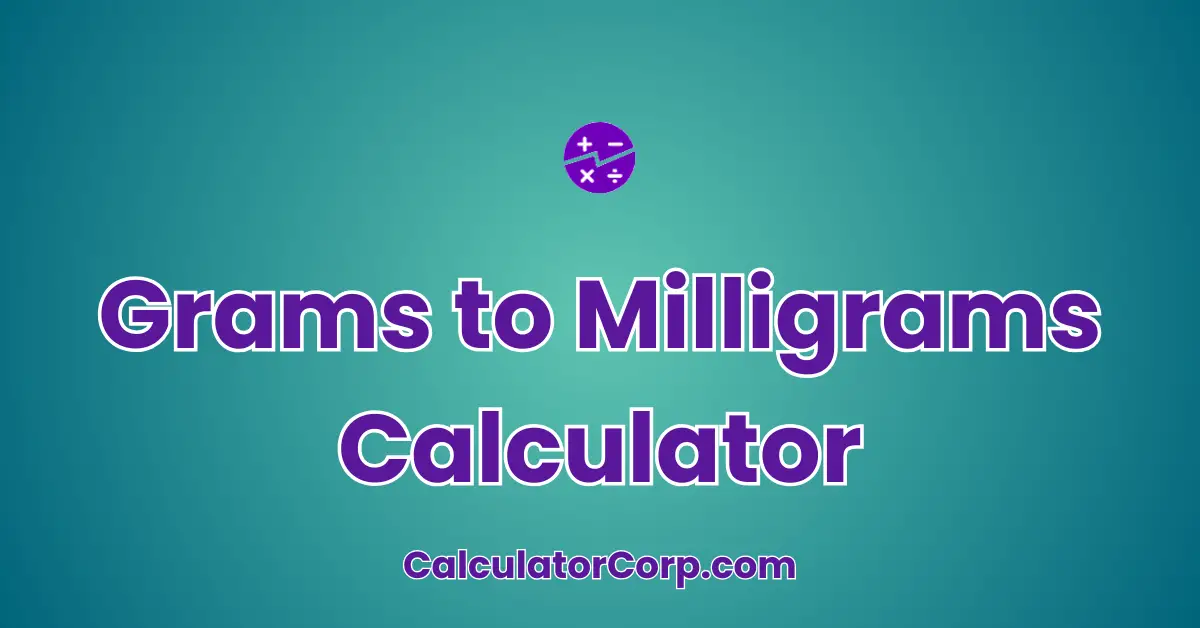The Grams to Milligrams Calculator is a tool designed to convert a weight in grams to milligrams. Its primary purpose is to assist you in obtaining accurate conversions quickly, which is essential in fields such as pharmaceuticals, chemistry, and nutrition. By using this calculator, you can save time and reduce errors that are common in manual calculations.
Grams to Milligrams Calculator
Select a value from the dropdown or enter your own value to see the conversion to milligrams. (1 gram = 1000 milligrams)
How to Use Grams to Milligrams Calculator?
To use the Grams to Milligrams Calculator, enter the weight in grams into the input field. The calculator will automatically convert this value into milligrams using the standard conversion factor.
Field Explanation: The input field accepts numerical data representing grams. Ensure the input is a valid number to avoid errors in calculation.
Result Interpretation: The output will display the equivalent weight in milligrams. For example, if you input “5” grams, the result will be “5,000 mg”.
Tips: Ensure you enter the correct value in grams. Avoid leaving empty fields or entering non-numeric characters to ensure accurate results.
Backend Formula for the Grams to Milligrams Calculator
The formula used in the calculator is straightforward: milligrams = grams × 1,000. This conversion factor is based on the metric system where 1 gram equals 1,000 milligrams.
Step-by-Step Breakdown: Starting with a given weight in grams, multiply this by 1,000 to obtain the weight in milligrams. This conversion is linear, meaning the relationship between the two units is constant.
Illustrative Example: If you have 2 grams of a substance, multiply by 1,000 to get 2,000 milligrams.
Common Variations: While this formula is standard, ensure to use the correct unit of grams to prevent conversion errors. Other conversions may involve kilograms or micrograms, but the principle remains similar.
Step-by-Step Calculation Guide for the Grams to Milligrams Calculator
Step 1: Enter the weight in grams in the provided field. For instance, input “3”.
Step 2: Press the “Calculate” button to see the result. The calculator will display “3,000 mg”.
User-Friendly Breakdown: This step multiplies the input by 1,000, which is easy to understand as simply shifting the decimal point three places to the right.
Examples: Entering “10” will yield “10,000 mg”, while “0.5” will result in “500 mg”.
Common Mistakes to Avoid: Double-check your input for typos, such as extra zeros, which can lead to vastly different results.
Real-Life Applications and Tips for Grams to Milligrams
Expanded Use Cases: Converting grams to milligrams is crucial in pharmaceutical dosing, where precise measurements are critical. It’s also essential in dietary calculations for nutrient intake.
Practical Tips: Always verify your input data for accuracy. When dealing with small quantities, rounding can introduce significant errors, so record data to a suitable number of decimal places.
Grams to Milligrams Case Study Example
Expanded Fictional Scenario: Meet Alex, a pharmacist who needs to convert medication dosages from grams to milligrams for patient prescriptions. By using the calculator, Alex ensures the dosages are precise, improving patient safety.
Alternative Scenarios: A chef may use the calculator to convert ingredient measurements for a recipe, ensuring flavor consistency.
Pros and Cons of Grams to Milligrams
List of Pros: The calculator offers speed and accuracy, allowing for quick conversions without manual errors. It facilitates informed decision-making by providing precise data.
List of Cons: Over-reliance on the tool without understanding the underlying mathematics might lead to errors if input data is incorrect.
Mitigating Drawbacks: Use the calculator as a reference point, but double-check calculations manually when precision is paramount.
Example Calculations Table
| Grams | Milligrams |
|---|---|
| 1 | 1,000 |
| 2.5 | 2,500 |
| 10 | 10,000 |
| 0.1 | 100 |
| 7.75 | 7,750 |
Table Interpretation: This table demonstrates the linear relationship between grams and milligrams. Note how increasing the grams scales the milligrams proportionally.
Glossary of Terms Related to Grams to Milligrams
Gram (g): A metric unit of mass equal to one thousandth of a kilogram. Used in everyday measurements.
Milligram (mg): A metric unit of mass equal to one thousandth of a gram. Common in precision measurements like pharmaceuticals.
Frequently Asked Questions (FAQs) about the Grams to Milligrams
How do I convert grams to milligrams? Multiply the number of grams by 1,000. This conversion is straightforward because the metric system is based on powers of ten.
Why is converting grams to milligrams important? This conversion is crucial when precise measurements are needed, such as in medicine or chemical formulations.
Can this calculator handle large values? Yes, the calculator can handle large values and will format them with a thousands separator for readability.
Is there a reverse calculation from milligrams to grams? Yes, divide the number of milligrams by 1,000 to convert back to grams.
What should I do if my result seems incorrect? Double-check your input for any errors, such as misplaced decimal points or additional zeros.
Further Reading and External Resources
Metric Conversions: Grams to Milligrams – Detailed explanations and conversion charts.
WikiHow: Convert Grams to Milligrams – A step-by-step guide with examples.
Sciencing: Convert Grams to Milligrams – Covers the importance of conversion in scientific contexts.

